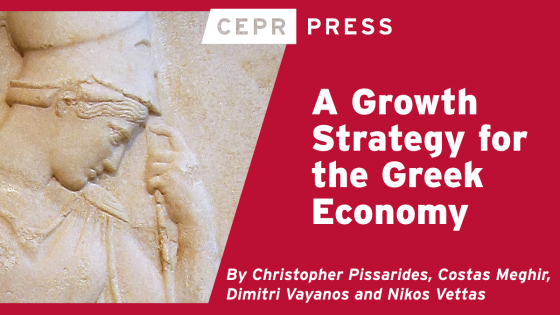In 1982 Mexico suffered a huge external shock. The price of oil – its major export – fell 65% between 1981 and 1986. Simultaneously, world interest rates surpassed 15%, making debt repayment impossible (Oks and van Wijnbergen 1994). Unlike Greece, Mexico received neither a bailout nor a debt-haircut at the beginning of its crisis. To rub salt in the wound, IMF funding stopped in 1985, right after a massive 8.1 magnitude earthquake stuck Mexico.1
Mexico’s external debt haircut – the Brady Plan – happened seven years after the onset of the crisis, and only after Mexico made permanent structural reforms while continuously servicing its debt.
Mexico’s debt service was painful – the public sector debt-service-to-GDP ratio averaged 15% between 1982 and 1988. In contrast, Greece’s debt-service-to-GDP ratio, which averaged 5% between 2008 and 2014, has been relatively light. See Figure 1.
Figure 1. Debt service (increased expenditure on public debt)

Sources: Eurostat, Ministry of Finance (Greece), and Centro de Estudios de las Finanzas.
Obviously, it would have been optimal for both the Mexican debt haircut and structural reforms to have occurred in 1982, and for Mexico to have received a bailout to smooth consumption during the rocky 1980s. Unfortunately this is not how the world works. In the late 1970s, Mexico had the time and the oil revenues to implement necessary structural reforms. Power-holders blocked attempts to reform during those good times.
The deep fiscal crisis and the lack of leniency from international organisations forced Mexican power-holders to have an ‘internal conversation’ on whether to become a liberalised economy or a statist economy. The outcome of such heated conversation was a radical trade liberalisation and privatisation program. Such decisions were politically difficult – they led to a deep political rift that ended in the breakup of the Institutional Revolutionary Party (PRI)’s long-lived hold on power.
Despite the forewarnings of experts, positive effects of the reforms became apparent quickly. The economy became a successful exporter of manufacturing goods and the value of manufacturing goods as a percentage of total goods exported increased sharply from 24% in 1982 to 71% in 1989. This is shown in Figure 2.
Figure 2. Mexico's goods exports

Source: Banco de México.
After seven difficult years, there was light at the end of the tunnel – Mexico's public debt-to-GDP ratio fell to 47% in 1989 (from 60% in 1982). In contrast, in the six years between 2008 and 2014, that of Greece increased from 109% to 176%. See Figure 3.
Figure 3. Public debt

Sources: European Commission, WDI and OECD.
In order to appreciate these contrasting experiences, the following figures compare Greece from the onset of its crisis in 2008 to the Mexico from the onset of its oil crisis in 1982.
We can capture the size of the negative external shock in two complementary ways:
- By the fall in the terms of trade (ToT) and
- By the collapse of private financial flows.
Figure 4 shows that Mexico’s ToT – the ratio of the price of exports to the price of imports – fell by 20% between 1981 and 1982, and continued falling every year, until by 1988 there had been a cumulative drop of 71%. In contrast, Greece’s ToT has declined by 5% between 2007 and 2013. The collapse in Mexico’s ToT reflected the fall in oil prices, as in 1981 oil represented 62% of its exports and 32% of its fiscal revenue.
Figure 4. Terms of trade (percentage ratio of the export unit value indexes to the import unit value indexes

Source: WDI.
Figure 5 shows the severe sudden stop. During the first year of crisis, private financial flows fell by 9% of GDP in Greece, while financial flows fell by 6% of GDP in Mexico.
Figure 5. Capital flows (Greece: Net private financial flows; and Mexico: net financial flows)

Sources: IMF BOPS and authors' calculations.
An economy-wide indicator of the adjustment to the external shock is the current account, which measures the excess of national income over national spending. Figure 6 shows that in 1982 Mexico’s current account improved by a whopping 8% of GDP as it jumped from a -6% deficit in 1981 to a +2% surplus, and had a cumulative 5% surplus from 1983 to 1988. In contrast, Greece’s current account remained in deficit from 2008 until 2012. From 2008 to 2014 the cumulative current account deficit was 47% of GDP.2
Figure 6. Current account

Sources: IMF BOPS.
The fiscal response lays behind the different current account responses. Figure 7 exhibits the primary fiscal balance, which excludes debt service. Despite a sharp recession, Mexico’s primary fiscal balance improved 13 percentage points from a deficit of 8% of GDP in 1981 to a 5% surplus in 1983. This surplus remained until the Brady plan was implemented. In contrast, between 2008 and 2013 Greece ran a primary fiscal deficit (6% of GDP on average). It reached a surplus of 2% of GDP in 2014.
Figure 7. Primary balance

Sources: ECB statistical data warehouse, OECD and WEO.
How could Greece run a current account deficit in the face of huge private capital outflows? As we can see in Figure 8, the answer is given by the remarkable jump in public capital inflows, which is roughly equal to the current account deficit plus private capital outflows.3 The public capital inflows include disbursements under the IMF/EU programs and the EU bailouts of 2010 and 2011. They also include the increase in credit from the ECB to the Bank of Greece via the Target2 balances.4
Figure 8. Greek balance of payments

Sources: authors' calculations using IMF BOPS.
In Mexico there was a sharp downsizing of the government, while in Greece there has not. First, Mexico's total government expenditure fell from 25% of GDP in 1982 to 17% of GDP in 1989. In Greece, it increased from 51% of GDP in 2008 to 59% of GDP in 2013. It only started
to decrease in 2014. Second, Mexico experienced a decline in the government wage bill from 7% of GDP in 1982 to 5% of GDP in 1988. In contrast, the Greek government’s wage bill increased from 11% in 2007 to 12% in 2013 (see Figures 9 and 10).5
Figure 9. Compensation of public-sector employees

Source: Eurostat and OECD.
Figure 10. Total government expenditures

Sources: Eurostat and OECD, and WEO.
Were the 1980s a lost decade for Mexico? The answer can go both ways.
Yes, because Mexico suffered through years of structural change, as it was implemented in the midst of large net transfers abroad associated with debt repayment and a collapse in the terms-of-trade – GDP growth averaged only 0.2% over 1982-1988.
No, because the seven lean years witnessed radical trade liberalisation and the dismantling of the regulatory state, which led to a 4% average GDP growth in 1989-19946 (see Figure 11).7
Figure 11. Real GDP growth

Source: WDI.
Concluding remarks
The Mexican Debt Crisis shows that leniency from international organisations towards has not helped Greece. Mexico received no bailout in the wake of the 1982 crisis. Moreover, a debt haircut occurred only after seven years of continuous debt repayment. This lack of leniency induced deep structural reforms, which led to the development of a competitive export sector and improved fiscal finances.
References
Tornell, A and F Westermann (2012), "The tragedy of the commons at the European Central Bank and the next rescue", VoxEU.org, 22 June.
Tornell, A and F Westermann (2011), "Greece: The sudden stop that wasn’t", VoxEU.org, 28 September.
Rancière, R, A Tornell, and F Westermann (2008) "Systemic Crises and Growth", The Quarterly Journal of Economics.
Oks, D and S van Wijnbergen (1994), “Mexico after the debt crisis: is growth sustainable?”, World Bank Policy Research Working Paper, WPS 1378.
Footnotes
1 An article published by The New York Times on September 21st, 1985 stated: "The IMF provoked strong criticism yesterday from some public officials who accused it of harshness and inflexibility after the earthquake, in which more than 1,300 people are believed to have died. ‘It reminds one of the banker who waits until it's snowing before evicting the man, the wife and the children from their home,’ said John McCain, a Republican Congressman from Arizona, as the House passed a resolution expressing sympathy and urging relief funds for Mexico.’ […] Apparently in response to the criticism, the IMF issued a statement last evening explaining that it had not taken any action against Mexico. Rather, the Fund suggested, it was Mexico that had missed economic targets, and therefore automatically was denied access to IMF loans.”
2 Puzzlingly, net external debt increased by 55% of GDP over this period. The discrepancy between the increase in net external debt and the cumulative current account deficit may be attributable to capital flight.
3 This Figure extends that of Tornell and Westermann, 'Greece“Greece: The sudden stop that wasn’t' wasn’t” (VOXEU, 2011).
4 See Tornell and Westermann, 'The “The tragedy of the commons at the European Central Bank and the next rescue' rescue” (VOXEU, 2012). The leniency with which international organizations have treated Greece can be gleaned from the statement by IMF managing director Christine Lagarde on March 9th, 2012: "My decision to recommend to the IMF’s Executive Board that the Fund should continue to assist Greece in this endeavor by providing substantial financial support over an extended period of time would be commensurate with the long-term nature of the challenges facing Greece and with the significant financial contributions provided by the private sector and by Euro Area member states. The scale and length of the Fund’s support is a reflection of our determination to remain engaged."
5 The structural change began with a large devaluation, a decrease in public expenditures, and an increase in tax revenues. Miguel De La Madrid announced his first stabilization program in December 1982, called the Programa Inmediato de Reordenación Económica, (Program of Immediate Economic Reorganization), PIRE. In 1989, the new president Salinas announced a new pact called the "Pact for Economic Stability and Growth" (PECE). This pact included plans to reprivatize banks and the signing of the North American Free Trade Agreement. These decisions restored confidence in Mexico and increased capital flows.
6 In 1994, Mexico suffered a financial crisis typical of countries that have liberalized financially and have been on a high growth path (Ranciere et.al. 2008).
7 The Brady Plan offered credit enhancements to banks in exchange for their agreement to reduce claims. For Mexico, banks chose to swap 49% of their loans for discount bonds, 41% for par bonds, and 10% to provide new money. The amount of commercial debt covered under the plan was worth 21.9% of GDP. The principal and interest payments on those bonds were collateralized with US Treasury bonds, which were financed by loans from the IMF and World Bank. Greece suffered from capital outflows starting in 2008. In May 2010, Eurozone countries, the ECB, and the IMF launched a €110 billion bailout loan to rescue Greece. A year later, in October 2011, Eurozone leaders agreed to offer a second bailout loan worth €130 billion for Greece. Moreover, debt restructure was implemented by Greece in 2012 with a nominal haircut of all privately held government bonds. All private creditors holding Greek government bonds were required to accept extended maturities, lower interest rates, and a 53.5% face value loss. This reduced both the public debt and the public debt-to-GDP ratio in 2012.
















